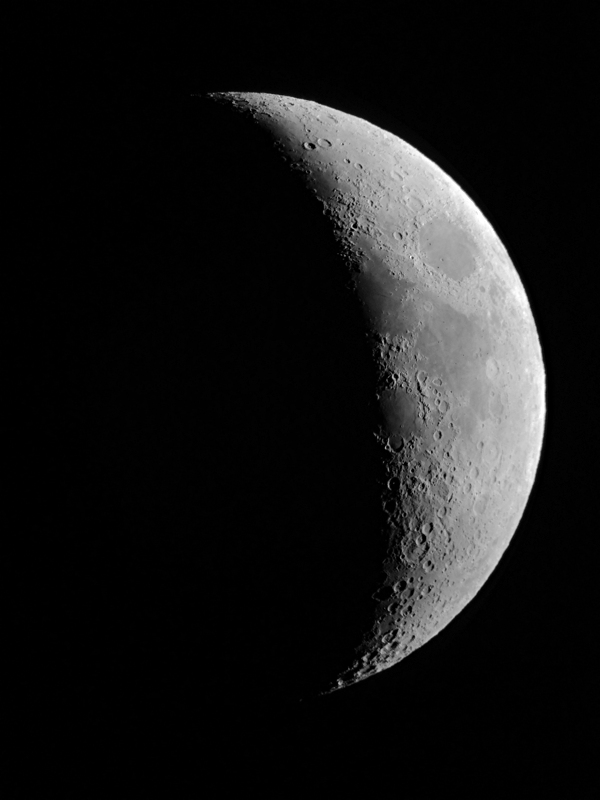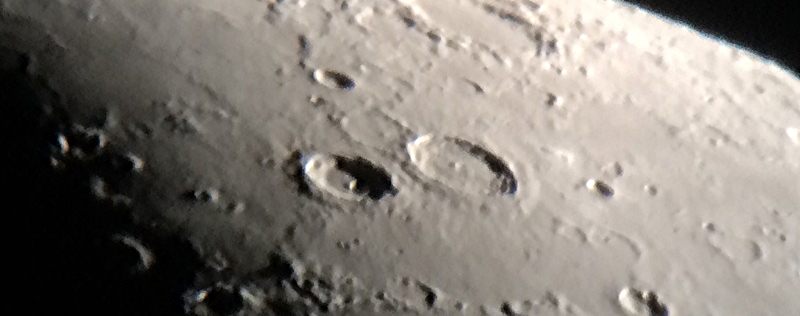
Lunar Craters Atlas and Hercules,
Comet C/2012 S1 (ISON)
Posted: 8 November 2013
The observatory was opened Thursday, 7 November 2013, at 1808 MST, 69°F. The sky was mostly clear, with some clouds low in the west. But there were strong breezes at times. This was planned to be a short session after a long day at the "Last A-7D Pilots Reunion". Viewed Venus, 83X, at 1814 MST.
Started lunar observing with the 8" LX200-ACF at 1819 MST, first with 83X and then 222X. There were some nice views along the terminator using 222X. The craters Atlas and Hercules were especially nice with the current lighting conditions. I decided to some iPhone afocal imaging of the moon using my homemade afocal adapter. This image shows the moon at 77X:

This is Atlas (right) and Hercules (left), afocal 231X, cropped from a full-frame iPhone 5s slo-mo video:

Ended imaging at 1840 MST, and did some more lunar observing. Seeing was not very good so the views at 364X were not very good. Reverted back to 222X, which provided better views of the moon. Also did some viewing in the earthlit portion of the moon, as well as along the illuminated lunar limb.
The observatory was closed at 1900 MST, 64°F.
I returned to the observatory at 0419 MST to do Comet C/2012 S1 (ISON) imaging. At 0425 MST, viewed Mars, 83X. No surface details visible. I then used SkySafari Pro and the GC Wi-Fi Adapter to GOTO Comet C/2012 S1 (ISON). Unfortunately, the comet was seen through tree branches. The coma was larger and somewhat brighter than I recalled from my previous Comet ISON observing on 2 November 2013. I then began preparing to image the comet. Mounted the D7000 DSLR at prime focus of the 8" LX200-ACF using an off-axis guider. Did a focus test image using the star Regulus with a Bahtinov Mask.
Then slewed back to the comet. The comet was not visible in the camera viewfinder at this time. No guide star was located. I did 1 minute, ISO 6400, unguided exposures every 2 minutes from 0442 MST to 0512 MST. The sixteen images were used to create this animated GIF, showing the comet's motion and its increasing brightness as it rose out of the tree:

With the comet now above the tree, at 0513 MST, I began searching for the comet using 7x50 binoculars. The comet was well within the Zodiacal Light cone. The comet was faintly visible in the 7x50 finderscope on the telescope, so I used that to point the direction towards the comet. I then located Comet ISON in the binoculars; it was a small faint fuzzy path, with no tail visible. I then viewed Comet C/2013 R1 (Lovejoy) using the binoculars. Comet Lovejoy was much nicer than Comet ISON; it showed as a large bright fuzzy object with a hint of a tail visible.
By 0519 MST, Comet ISON was faintly visible in the D7000 viewfinder. I searched again for a guide star, but found none suitable. At 0533 MST, I took this unguided 2 minute, ISO 6400, exposure. Stars trailed but I got lucky and the tracking error resulted in good tracking on the comet. The image was edited to bring out the tail.

The eastern sky was now beginning to brighten. I ended imaging at 0545 MST, and took a final look at Comet ISON, 83X. Unfortunately, the sky background was now too bright for good viewing and only the comet's coma was visible. This might have been my last opportunity to view Comet C/2012 S1 (ISON) prior to perihelion (28 November) from the observatory. Its low elevation in the sky, nearby trees, and even clouds returning in the forecasts, will all work against me.
The observatory was closed at 0600 MST, 57°F.
Comments are welcome using Email. Thanks.
(Use of the LiveFyre comments system has been discontinued due to low usage.)
Cassiopeia Observatory Home Page